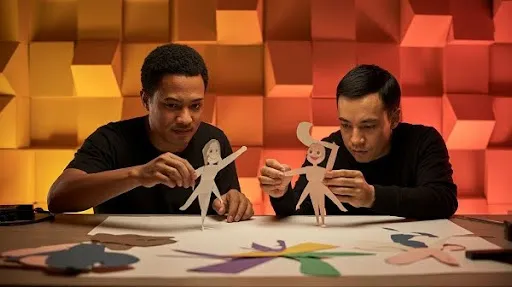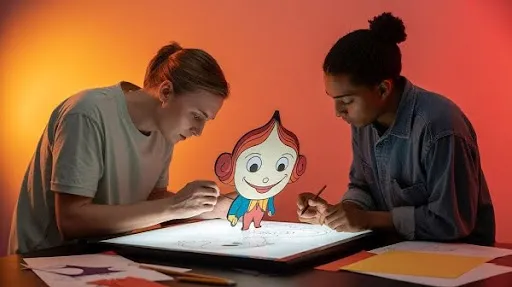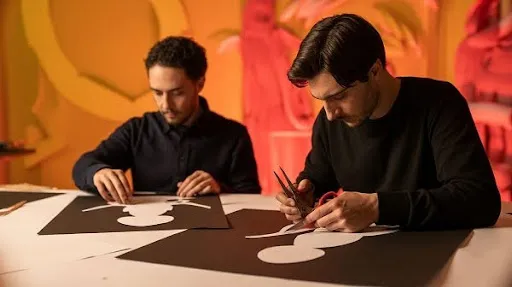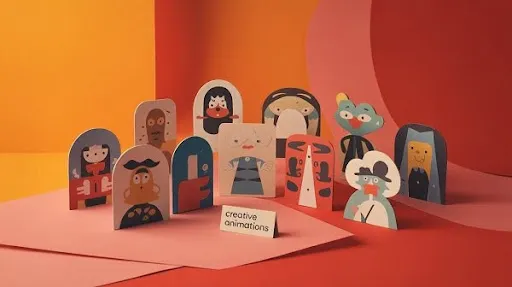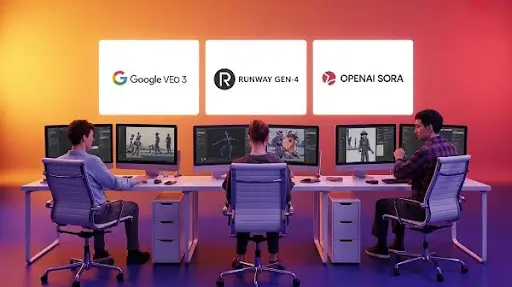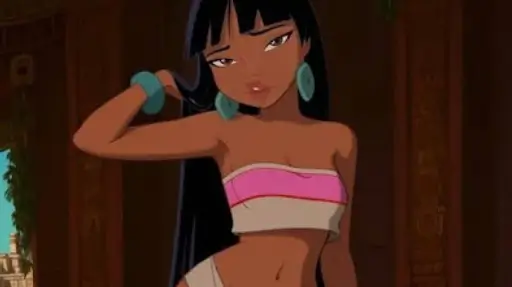Cut out animation, sometimes written as cut-out or cutout animation, is one of the simplest and most enjoyable forms of stop motion. It’s highly accessible, easy to create, and most importantly—fun for all ages.
The charm of cut-out animation lies in its straightforward art style, simple materials, and easy techniques used to bring stories to life. Yet, despite its simplicity, it can also be adapted for more detailed and complex animations.
Whether you’re a child experimenting with creativity or an adult exploring storytelling, your imagination is the only limit. Many creators even combine cut-out animation with 3d animation services to add depth and a modern twist to their projects.
What is Cut Out Animation?
Cut out animation is one of the oldest forms of 2D animation. It creates 2D movement using characters, props, and backgrounds made from materials such as:
- Paper
- Card
- Fabric
Characters are usually built from smaller cut-out shapes, assembled like a collage, and placed flat on a background. By moving the pieces in small steps and photographing each frame, animators create the illusion of smooth movement.
One of the most famous examples of this technique is The Adventures of Prince Achmed (1926), directed by German filmmaker Lotte Reiniger. It is considered the oldest surviving feature-length animation, made entirely using cut out methods.
Today, cut out animation has evolved. While it can still be created traditionally with physical materials, modern technology allows it to be replicated digitally using animation software—combining old-fashioned charm with new possibilities.
In short, cut out animation is a timeless technique that balances simplicity and creativity, making it a favorite for both beginners and professionals alike.
Cut-Out Animation Techniques
Over the years, cut-out animation has been known for its quirky and simplistic style. Traditionally, artists created this form of animation by hand, using paper or other materials to design characters and scenery.
While inexpensive, the process was time-consuming, requiring patience and precision to bring each element to life frame by frame.
With advancements in digital technology, the way cut-out animation is produced has transformed. Today, many animation studios use specialized software to recreate the look and feel of traditional cut-out animation on computers.
These tools allow animators to add pivot points to character body parts, making it easy to connect and animate them just like paper cut-outs.
Digital cut-out animation offers significant advantages. It speeds up production, reduces costs, and still delivers the charm of the classic technique. However, it also comes with limitations. The digital process can sometimes feel less flexible and may lack the raw, handcrafted appeal of traditional paper animation.
For many creators, there is a unique sense of pride in crafting an authentic piece by hand, even if it takes longer and looks rough around the edges.
The Advantages of Paper Animation
Despite the rapid growth of digital tools and advanced animation software, paper animation continues to hold a special place for both beginners and seasoned professionals. Its simplicity, charm, and creative potential make it a timeless medium. Here are some of its key advantages:
It’s fun and creative.
Paper cut-out animation taps into pure imagination. It brings us back to the days of childhood when storytelling was free-spirited and playful. The process allows animators to experiment and stretch their creativity in ways that are both enjoyable and rewarding.
It’s affordable and accessible.
Creating paper animations doesn’t require expensive equipment or materials. Everyday items like paper, scissors, and glue are often enough. You can even reuse and recycle materials, making it one of the most budget-friendly animation techniques available.
A great starting point for beginners.
Because it is simple and inexpensive, paper animation is an excellent gateway for newcomers. It provides an easy introduction to the principles of movement and visual storytelling without overwhelming complexity.
Opportunities to make films.
Paper cut-out animation has a proud history, with pioneers like Lotte Reiniger inspiring generations. With just a little effort, you can create your own stop-motion films and explore the artistry that made this style so influential.
Time-saving and efficient.
Unlike cel animation or modern 3D processes, paper animation requires fewer resources and less time. Assets can be reused, and cut-outs demand fewer drawings, making the overall process quicker while still delivering strong results.
A creative challenge for professionals.
For experienced animators, the stripped-down nature of paper animation can be an exciting test of skill. Working within such basic limitations often sparks innovative ideas and fresh approaches to storytelling.
Perfect for social media.
Paper cut-out animation is naturally eye-catching and short-form friendly, making it ideal for platforms like TikTok, Instagram, or YouTube. A clever clip has the potential to connect with wide audiences and even go viral.
It evokes nostalgia.
For many, paper animation is a return to the basics—a reminder of the joy found in early creative projects. For professionals, it can feel like reconnecting with the roots of their craft, bringing both satisfaction and inspiration.
How to Make a Paper Cut-Out Animation
Here’s a step-by-step guide to making your very own cut out animation.
Gather Your Materials
Start by collecting everything you’ll need. Common materials include card, paper, felt, fabric, and wool. You’ll also need adhesives such as Blu-Tack or glue, scissors, pencils, paper, and possibly wire. Think about your project before you begin:
- Do you want simple card silhouettes like in The Adventures of Prince Achmed?
- Would stronger materials like card be better than paper?
- Will wire joints give your characters more freedom of movement, or would Blu-Tack be enough?
Plan Your Story
Before you start cutting and building, decide what story you want to tell. What characters will you use? How long should your animation be? Make notes and create a simple plan. Having a clear outline will make the whole process smoother.
Design Your Characters
Think about how your characters will look and move. Sketch out several ideas before settling on a final version. Pay attention to overlapping features like ears, mouths, or arms, and decide how they will connect with the rest of the body. This planning will save time later.
Assemble the Characters
Once you’ve chosen your final designs, draw and cut them out into movable pieces. Lay them out on your chosen background, which could be detailed or just plain paper, depending on the style you want.
Connect the Pieces
If you’re a beginner, keep things simple. Use Blu-Tack to join pieces so they stay together but still allow movement—perfect for swinging arms or turning heads. For parts that shouldn’t move, use glue to hold them firmly in place.
Choose a Stop-Motion App
The easiest way to capture your animation is with a smartphone camera and a stop-motion app. There are many free and paid options available. If you’d like to refine your work later, you can import your images into software like Photoshop for more detailed editing.
Prepare Your Filming Space
Set up a flat, stable surface in a room where you can control the lighting. Lamps are best for consistent light, as natural light changes over time. Keep your camera completely still throughout the shoot—using a tripod will make this much easier.
Shoot Your Animation
Now you’re ready to bring your characters to life. Standard animation runs at 24 frames per second (fps), but for beginners, 12 fps is easier and still looks good. Take your time, moving your cut-outs a little between each shot, and watch your story come alive frame by frame.
Cut-Out Animation Examples
There are plenty of inspiring cut-out animation works available to explore online. Below are some standout examples worth checking out.
The adorable one
Coco is a sweet paper cut-out animation by Katherine Manaog, inspired by the pets she missed after moving abroad for art school. Working with Annie Wong and Louie Zhang, she transformed simple paper shapes into heartwarming characters that radiate charm.
The whimsical one
To promote the children’s book Don’t Rake Your Garden in a Party Dress by Aimee Bissonette, illustrator Kelly Pousette crafted a delightful cut-out animation. Using quirky collages from the book itself, she brought her illustrations to life in a playful and magical way.
The old-school one
Leander Huizinga’s The Tree takes cut-out animation back to its roots. With striking black silhouettes set against a plain white background, it recalls the earliest days of the technique while keeping the storytelling simple yet powerful.
The advanced one
Once Upon a Dream is a stop-motion wedding film that beautifully blends live actors with cut-out animated art by Shirie Gordon-Feliks. It’s a perfect example of how traditional animation can merge seamlessly with modern filmmaking for a unique, memorable result.
The dark one
In Elsewhere, The Survivors, Ali Aschman creates a haunting cut-out world filled with bleak landscapes and troubled characters. This work explores themes of doubt and anxiety, showing how animation can evoke deep, unsettling emotions.
The musical one
The music video for Giangrande’s Paper Plane was brought to life with a collaborative cut-out animation. Illustrated by Felicita Sala and directed by Gianluca Maruotti, it pairs whimsical visuals with the rhythm of the song to create a charming artistic experience.
The epic one
Josh Ritter’s Love is Making its Way Back Home stands out for its sheer ambition. The video, created by Prominent Figures, used more than 12,000 pieces of construction paper—crafted and animated without any digital effects. The result is both stunning and monumental.
The imaginative one
Voyage by Ali Azami, Bri Levy, and John McGraw is a playful reminder of the limitless creativity cut-out animation offers. Its inventive characters and storytelling showcase just how boundless the art form can be.
The natural one
MoSoMoS studio produced a stop-motion paper animation for Sesame Workshop that beautifully captures the life cycle of a tree. It’s a gentle, nature-inspired piece that demonstrates how paper animation can bring organic processes to life.
The romantic one
Wang Jingjie’s Whistle and Love offers a lighthearted, witty take on relationships. Through clever use of paper cut-outs, it captures the humor and sweetness of love in a visually engaging way.
Cut out animation: FAQs.
Who invented cut-out animation?
Cut-out animation was first created by Quirino Cristiani, an Italian-born Argentine director and cartoonist. In 1916, he made La intervención en la provincia de Buenos Aires, a one-minute film using cardboard cut-outs. Sadly, the film was later lost in a fire. The oldest surviving example of cut-out animation is Lotte Reiniger’s feature-length masterpiece Die Abenteuer des Prinzen Achmed (1926), which remains a landmark in animation history.
Where is cut-out animation used?
Because of its simplicity and cost-effectiveness, cut-out animation has been widely used across different forms of media for decades—and it continues to thrive today. Some well-known examples include:
- Short films: The Miracle of Flight by Terry Gilliam (1974)
- Feature films: South Park: Bigger, Longer & Uncut (1999)
- Television series: Captain Pugwash (1957–66, 1974–75)
- Music videos: Talking Heads’ And She Was (1985)
How does the cut-out technique save production time?
Unlike traditional cel animation, cut-out animation doesn’t require redrawing every frame. Once the cut-out pieces are created, they can be rearranged and reused to create motion. This makes the process much faster and more efficient. Traditional paper cut-out animation also requires very little equipment and can even be done as a DIY project, making it both accessible and time-saving.

